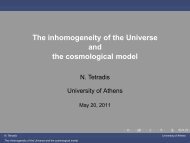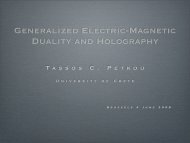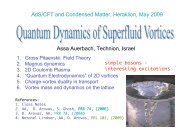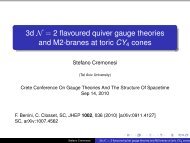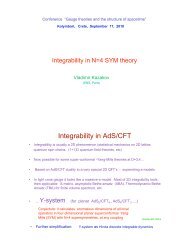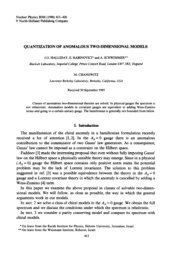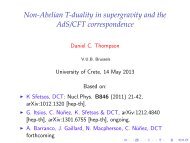(Quasi)-De Sitter Spacetime
(Quasi)-De Sitter Spacetime
(Quasi)-De Sitter Spacetime
You also want an ePaper? Increase the reach of your titles
YUMPU automatically turns print PDFs into web optimized ePapers that Google loves.
The Effective Theory of Inflation,<br />
Cosmological Observations<br />
Contrasted with Quantum Fields in<br />
(<strong>Quasi</strong>)-<strong>De</strong> <strong>Sitter</strong> <strong>Spacetime</strong><br />
H. J. de Vega<br />
LPTHE, CNRS/Université P & M Curie (Paris VI).<br />
THE PHYSICS OF DE SITTER SPACETIME<br />
ALBERT EINSTEIN INSTITUT HANNOVER, GERMANY SEPTEMBER 11-14, 2012<br />
The Effective Theory of Inflation, Cosmological Observations Contrasted with Quantum Fields in (<strong>Quasi</strong>)-<strong>De</strong> <strong>Sitter</strong> <strong>Spacetime</strong> – p. 1/2
DM + Λ + Baryons + Radiation<br />
The Standard Cosmological Model = Concordance Model<br />
Begins by the inflationary era. Slow-Roll inflation<br />
explains horizon and flatness.<br />
Gravity is described by Einstein’s General Relativity.<br />
Particle Physics described by the Standard Model of<br />
Particle Physics: SU(3) ⊗ SU(2) ⊗ U(1) =<br />
qcd+electroweak model.<br />
Dark matter is non-relativistic during the matter<br />
dominated era where structure formation happens. DM<br />
is outside the SM of particle physics. CDM =⇒ WDM.<br />
Dark energy described by the cosmological constant Λ.<br />
The Effective Theory of Inflation, Cosmological Observations Contrasted with Quantum Fields in (<strong>Quasi</strong>)-<strong>De</strong> <strong>Sitter</strong> <strong>Spacetime</strong> – p. 2/2
Standard Model of the Universe: Concordance Model<br />
ds 2 = dt 2 − a 2 (t) d�x 2 : spatially flat geometry.<br />
The Universe starts by an INFLATIONARY ERA.<br />
Inflation = Accelerated Expansion: d2 a<br />
dt 2 > 0.<br />
During inflation the universe expands by at least sixty or so<br />
efolds: e 66 ≃ 10 29 . Inflation lasts ≃ 10 −36 sec and ends by<br />
z ∼ 10 27 followed by a radiation dominated era.<br />
Matter can be effectively described during inflation by a<br />
single Scalar Field φ(t,x) : the Inflaton.<br />
Lagrangean: L = a3 �<br />
˙φ 2 (∇φ)2<br />
(t) 2 − 2 a2 �<br />
(t) − V (φ) .<br />
� �<br />
˙φ 2<br />
+ V (φ) , H(t) ≡ ˙a(t)/a(t).<br />
Friedmann eq.: H 2 (t) = 1<br />
3 M 2 Pl<br />
Slow-roll =⇒ quasi-de <strong>Sitter</strong> space-time.<br />
If ˙ φ 2 ≪ V (φ) ≃ ¯ V =⇒ a(t) = ā e ¯ H t , ¯ H = √ ¯V /[ √ 3 MPl]<br />
2<br />
The Effective Theory of Inflation, Cosmological Observations Contrasted with Quantum Fields in (<strong>Quasi</strong>)-<strong>De</strong> <strong>Sitter</strong> <strong>Spacetime</strong> – p. 3/2
The Theory of Inflation<br />
We describe inflation as an effective field in the<br />
Ginsburg-Landau sense.<br />
D. Boyanovsky, C. <strong>De</strong>stri, H. J. de Vega, N. G. Sánchez,<br />
(review article),<br />
arXiv:0901.0549, Int. J. Mod.Phys. A 24, 3669-3864 (2009).<br />
Relevant effective theories in physics:<br />
Ginsburg-Landau theory of superconductivity. It is an<br />
effective theory for Cooper pairs in the microscopic<br />
BCS theory of superconductivity.<br />
The O(4) sigma model for pions, the sigma and photons<br />
at energies � 1 GeV. The microscopic theory is QCD:<br />
quarks and gluons. π ≃ ¯qq , σ ≃ ¯qq .<br />
The theory of second order phase transitions à la<br />
Landau-Kadanoff-Wilson... (ferromagnetic,<br />
antiferromagnetic, liquid-gas, Helium 3 and 4, ...)<br />
....<br />
The Effective Theory of Inflation, Cosmological Observations Contrasted with Quantum Fields in (<strong>Quasi</strong>)-<strong>De</strong> <strong>Sitter</strong> <strong>Spacetime</strong> – p. 4/2
Slow-roll evolution of the Inflaton<br />
During slow-roll the inflaton derivatives are small and the<br />
evolution equations can be approximated by:<br />
3H(t) ˙ φ + V ′ (φ) = 0 , H 2 (t) =<br />
V (φ)<br />
3M 2 Pl<br />
These first order equations can be solved in closed from as:<br />
M 2 Pl N[φ] = − � φend<br />
φ<br />
V (ϕ) dϕ<br />
dV dϕ , eN[φ] = a(φend)/a(φ) ,<br />
N[φ] = the number of e-folds since the field φ exits the<br />
horizon till the end of inflation. N ∼ 60.<br />
φend = absolute minimum of V (φ).<br />
Therefore, φ2 = scales as N M2 Pl . We define:<br />
χ ≡<br />
φ<br />
√ N MPl<br />
= is a dimensionless and slow field.<br />
Universal form of the slow-roll inflaton potential:<br />
V (φ) = N M 4 w(χ), M = energy scale of inflation<br />
The Effective Theory of Inflation, Cosmological Observations Contrasted with Quantum Fields in (<strong>Quasi</strong>)-<strong>De</strong> <strong>Sitter</strong> <strong>Spacetime</strong> – p. 5/2
χ =<br />
φ<br />
√ N MPl<br />
m ≡ M2<br />
MPl<br />
SLOW and Dimensionless Variables<br />
, τ =<br />
√m t , H(τ) =<br />
N H(t)<br />
m √ N ,<br />
, |V ′′ (0)| = m 2 = inflaton mass, (|w ′′ (0)| = 1)<br />
slow inflaton, slow time, slow Hubble.<br />
χ and w(χ) are of order one.<br />
Evolution Equations:<br />
H2 (τ) = 1 � �<br />
1 dχ<br />
3 2 N dτ<br />
1<br />
N<br />
� 2<br />
+ w(χ)<br />
d2χ dχ<br />
+ 3 H<br />
dτ2 dτ + w′ (χ) = 0 .<br />
1/N terms: corrections to slow-roll<br />
Higher orders in slow-roll are obtained systematically by<br />
expanding the solutions in 1/N.<br />
�<br />
,<br />
The Effective Theory of Inflation, Cosmological Observations Contrasted with Quantum Fields in (<strong>Quasi</strong>)-<strong>De</strong> <strong>Sitter</strong> <strong>Spacetime</strong> – p. 6/2
70<br />
60<br />
50<br />
40<br />
30<br />
20<br />
10<br />
Exact Inflaton Dynamics: w(χ) = y<br />
32 (χ2 − 8<br />
y )2<br />
log a(τ) vs. τ<br />
0<br />
0 0.5 1 1.5 2 2.5 3 3.5 4<br />
0.8<br />
0.7<br />
0.6<br />
0.5<br />
0.4<br />
0.3<br />
0.2<br />
0.1<br />
H(τ) vs. τ<br />
0<br />
0 0.5 1 1.5 2 2.5 3 3.5 4<br />
The Effective Theory of Inflation, Cosmological Observations Contrasted with Quantum Fields in (<strong>Quasi</strong>)-<strong>De</strong> <strong>Sitter</strong> <strong>Spacetime</strong> – p. 7/2
Slow-roll Inflaton Dynamics<br />
Integrating the inflaton evolution eqs. to the order 1/N:<br />
log a(t)<br />
a(0) =<br />
�<br />
2 N<br />
3 y m t − 1 ϕ<br />
8<br />
2 (0)<br />
M2 � √ 2 y<br />
e 3 N<br />
Pl<br />
m t �<br />
− 1<br />
� �<br />
2 N<br />
H(t) = m 3 y 1 − y<br />
√ 2 y<br />
8 N e m t� 3 N<br />
ϕ 2 (0)<br />
M 2 Pl<br />
Hubble H(t) slowly decreases during slow-roll.<br />
<strong>De</strong> <strong>Sitter</strong> universe plus 1/N corrections:<br />
During slow-roll the universe is quasi-<strong>De</strong> <strong>Sitter</strong>.<br />
H(end slow − roll) ≃ H(slow − roll beginning)/ √ N<br />
√<br />
N ≃ 8<br />
� � 2<br />
3 N 8 N MPl m tend slow−roll = 2 y log y ϕ2 �<br />
(0)<br />
The Slow-roll regime is an attractor<br />
(Belinsky-Grishchuk-Zeldovich-Khalatnikov, 1985)<br />
The Effective Theory of Inflation, Cosmological Observations Contrasted with Quantum Fields in (<strong>Quasi</strong>)-<strong>De</strong> <strong>Sitter</strong> <strong>Spacetime</strong> – p. 8/2
Primordial Power Spectrum<br />
Adiabatic Scalar Perturbations: P(k) = |∆ (S)<br />
k ad |2 k ns−1 .<br />
To dominant order in slow-roll:<br />
|∆ (S)<br />
k ad |2 = N2<br />
12 π2 � �4 3<br />
MMPl<br />
w (χ)<br />
w ′2 (χ) .<br />
Hence, for all slow-roll inflation models:<br />
|∆ (S) N<br />
k ad | ∼<br />
2 π √ 3<br />
� MMPl<br />
� 2<br />
The WMAP result: |∆ (S)<br />
k ad | = (0.494 ± 0.1) × 10−4<br />
determines the scale of inflation M (using N ≃ 60)<br />
� MMPl<br />
� 2<br />
= 0.85 × 10 −5 −→ M = 0.70 × 10 16 GeV<br />
The inflation energy scale turns to be the grand unification<br />
energy scale !! We find the scale of inflation without<br />
knowing the tensor/scalar ratio r !!<br />
The scale M is independent of the shape of w(χ).<br />
The Effective Theory of Inflation, Cosmological Observations Contrasted with Quantum Fields in (<strong>Quasi</strong>)-<strong>De</strong> <strong>Sitter</strong> <strong>Spacetime</strong> – p. 9/2
spectral index ns, the ratio r and the running of ns<br />
r ≡ ratio of tensor to scalar fluctuations.<br />
tensor fluctuations = primordial gravitons.<br />
ns − 1 = − 3<br />
N<br />
dns<br />
d ln k<br />
= − 2<br />
N 2<br />
�<br />
w ′ �2 (χ)<br />
w(χ)<br />
w ′ (χ) w ′′′ (χ)<br />
w 2 (χ)<br />
+ 2<br />
N<br />
− 6<br />
N 2<br />
w ′′ (χ)<br />
w(χ)<br />
χ is the inflaton field at horizon exit.<br />
[w ′ (χ)] 4<br />
w 4 (χ)<br />
, r = 8<br />
N<br />
+ 8<br />
N 2<br />
�<br />
w ′ �2 (χ)<br />
w(χ)<br />
[w ′ (χ)] 2 w ′′ (χ)<br />
w 3 (χ)<br />
ns −1 and r are always of order 1/N ∼ 0.02 (model indep.)<br />
Running of ns of order 1/N 2 ∼ 0.0003 (model independent).<br />
Primordial Non-gaussianity fNL = order 1/N<br />
D. Boyanovsky, H. J. de Vega, N. G. Sanchez,<br />
Phys. Rev. D 73, 023008 (2006), astro-ph/0507595.<br />
The Effective Theory of Inflation, Cosmological Observations Contrasted with Quantum Fields in (<strong>Quasi</strong>)-<strong>De</strong> <strong>Sitter</strong> <strong>Spacetime</strong> – p. 10/2<br />
,
Ginsburg-Landau Approach<br />
Ginsburg-Landau potentials:<br />
polynomials in the field starting by a constant term.<br />
Linear terms can always be eliminated by a constant shift of<br />
the inflaton field.<br />
The quadratic term can have a positive or a negative sign:<br />
�<br />
w ′′ (0) > 0 → single well potential → large field (chaotic) inflation<br />
w ′′ (0) < 0 → double well potential → small field (new) inflation<br />
The inflaton potential must be bounded from below =⇒<br />
highest order term must be even with a positive coefficient.<br />
Renormalizability =⇒ degree of the inflaton potential ≤ 4.<br />
The theory of inflation is an effective theory =⇒<br />
higher degree potentials are acceptable<br />
Stability under the addition of terms of higher order.<br />
Otherwise, the description obtained could not be trusted.<br />
The Effective Theory of Inflation, Cosmological Observations Contrasted with Quantum Fields in (<strong>Quasi</strong>)-<strong>De</strong> <strong>Sitter</strong> <strong>Spacetime</strong> – p. 11/2
Fourth order Ginsburg-Landau inflationary models<br />
w(χ) = wo ± χ2<br />
V (φ) = N M 4 w<br />
m = M2<br />
MPl<br />
Notice that<br />
� MMPl<br />
� 2<br />
2 + G3 χ 3 + G4 χ 4 , G3 = O(1) = G4<br />
�<br />
√<br />
φ<br />
N MPl<br />
, g = m<br />
√ N<br />
≃ 10 −5 ,<br />
�<br />
� MMPl<br />
� MMPl<br />
� 4<br />
= Vo ± m2<br />
2 φ2 + g φ 3 + λ φ 4 .<br />
� 2<br />
G3 , λ = G4<br />
N<br />
� MMPl<br />
≃ 10 −10 , N ≃ 60 .<br />
Small couplings arise naturally as ratio of two energy<br />
scales: inflation and Planck.<br />
The inflaton is a light particle:<br />
m = M2<br />
MPl ≃ 0.003 M , m = 2.5 × 1013 GeV<br />
H ∼ √ N m ≃ 2 × 10 14 GeV.<br />
The Effective Theory of Inflation, Cosmological Observations Contrasted with Quantum Fields in (<strong>Quasi</strong>)-<strong>De</strong> <strong>Sitter</strong> <strong>Spacetime</strong> – p. 12/2<br />
� 4
MCMC Results for double–well inflaton potential<br />
Bounds: r > 0.023 (95% CL) , r > 0.046 (68% CL)<br />
Most probable values: ns ≃ 0.964, r ≃ 0.051 ⇐measurable!!<br />
The most probable double–well inflaton potential has a<br />
moderate nonlinearity with the quartic coupling y ≃ 1.26....<br />
The χ → −χ symmetry is here spontaneously broken<br />
since the absolute minimum of the potential is at χ �= 0<br />
w(χ) = y<br />
�<br />
32 χ2 − 8 �2 y<br />
MCMC analysis calls for w ′′ (χ) < 0 at horizon exit<br />
=⇒ double well potential favoured.<br />
C. <strong>De</strong>stri, H. J. de Vega, N. Sanchez, MCMC analysis of<br />
WMAP data points to broken symmetry inflaton potentials<br />
and provides a lower bound on the tensor to scalar ratio,<br />
Phys. Rev. D77, 043509 (2008), astro-ph/0703417.<br />
The Effective Theory of Inflation, Cosmological Observations Contrasted with Quantum Fields in (<strong>Quasi</strong>)-<strong>De</strong> <strong>Sitter</strong> <strong>Spacetime</strong> – p. 13/2
MCMC Results for the double–well inflaton potential<br />
r<br />
0.3<br />
0.25<br />
0.2<br />
0.15<br />
0.1<br />
0.05<br />
0<br />
0.9 0.92 0.94 0.96 0.98 1 1.02 1.04<br />
n<br />
s<br />
Solid line for N = 50 and dashed line for N = 60<br />
White dots: z = 0.01 + 0.11 ∗ n, n = 0, 1,...,9,<br />
y increases from the uppermost dot y = 0, z = 1.<br />
The Effective Theory of Inflation, Cosmological Observations Contrasted with Quantum Fields in (<strong>Quasi</strong>)-<strong>De</strong> <strong>Sitter</strong> <strong>Spacetime</strong> – p. 14/2
0.14<br />
0.12<br />
0.1<br />
0.08<br />
0.06<br />
0.04<br />
0.02<br />
The universal banana region<br />
quartic double well<br />
quadratic + u ∞ double well<br />
0<br />
0.92 0.93 0.94 0.95<br />
n<br />
s<br />
0.96 0.97 0.98<br />
We find that all r = r(ns) curves for double–well inflaton<br />
potentials in the Ginsburg-Landau spirit fall inside the<br />
universal banana region B.<br />
The lower border of B corresponds to the limiting potential:<br />
w(χ) = 4 y − 1 2 χ2 � �<br />
8y 8y<br />
for χ < , w(χ) = +∞ for χ ><br />
This gives a lower bound for r for all potentials in the<br />
Ginsburg-Landau class: r > 0.021 for the current best value<br />
of the spectral index ns = 0.964.<br />
The Effective Theory of Inflation, Cosmological Observations Contrasted with Quantum Fields in (<strong>Quasi</strong>)-<strong>De</strong> <strong>Sitter</strong> <strong>Spacetime</strong> – p. 15/2
Loop Quantum Corrections to Slow-Roll Inflation<br />
φ(�x,t) = Φ0(t)+ϕ(�x,t), Φ0(t) ≡< φ(�x,t) >, < ϕ(�x,t) >= 0<br />
�<br />
a�k χk(η) ei� �<br />
k·�x + h.c. ,<br />
ϕ(�x,t) = 1<br />
a(η)<br />
� d 3 k<br />
(2 π) 3<br />
a †<br />
� k , a �k are creation/annihilation operators,<br />
χk(η) are mode functions. η = conformal time.<br />
To one loop order the equation of motion for the inflaton is<br />
¨Φ0(t) + 3H ˙ Φ0(t) + V ′ (Φ0) + g(Φ0) 〈[ϕ(x,t)] 2 〉 = 0<br />
where g(Φ0) = 1 ′′′<br />
2 V (Φ0).<br />
The mode functions obey:<br />
χ ′′<br />
k (η) +<br />
�<br />
k2 + M2 (Φ0) a2 (η) − a′′<br />
(η)<br />
a(η)<br />
�<br />
χk(η) = 0<br />
where M 2 (Φ0) = V ′′ (Φ0) = 3 H 2 0 ηV + O(1/N 2 )<br />
The Effective Theory of Inflation, Cosmological Observations Contrasted with Quantum Fields in (<strong>Quasi</strong>)-<strong>De</strong> <strong>Sitter</strong> <strong>Spacetime</strong> – p. 16/2
Quantum Corrections to the Friedmann Equation<br />
The mode functions equations for slow-roll become,<br />
χ ′′<br />
k (η)+<br />
�<br />
k2 − ν2− 1<br />
4<br />
η2 �<br />
χk(η) = 0 , ν = 3 2 +ǫV −ηV + O(1/N 2 ).<br />
The scale factor during slow roll is a(η) = −H0<br />
η (1−ǫV ) .<br />
Slow-roll parameters of order 1/N:<br />
ǫV = 1 2 M2 Pl<br />
� V ′ (Φ0)<br />
V (Φ0)<br />
� 2<br />
, ηV = M 2 Pl<br />
V ′′ (Φ0)<br />
V (Φ0)<br />
D. Boyanovsky, H. J. de Vega, N. G. Sanchez,<br />
Quantum corrections to slow roll inflation and new scaling<br />
of superhorizon fluctuations. Nucl. Phys. B 747, 25 (2006),<br />
astro-ph/0503669.<br />
Quantum corrections to the inflaton potential and the power<br />
spectra from superhorizon modes and trace anomalies,<br />
Phys. Rev. D 72, 103006 (2005), astro-ph/0507596.<br />
The Effective Theory of Inflation, Cosmological Observations Contrasted with Quantum Fields in (<strong>Quasi</strong>)-<strong>De</strong> <strong>Sitter</strong> <strong>Spacetime</strong> – p. 17/2<br />
1
Quantum Corrections in slow-roll<br />
Scale invariant case: ν = 3 2 . ∆ ≡ 3 2 − ν = ηV − ǫV controls<br />
the departure from scale invariance.<br />
Explicit solutions in slow-roll:<br />
χk(η) = 1 2<br />
√ −πη i ν+ 1<br />
2 H (1)<br />
ν (−kη), H (1)<br />
ν (z) = Hankel function<br />
Quantum fluctuations: 〈[ϕ(x,t)] 2 〉 = 1<br />
a2 (η)<br />
1<br />
2 〈[ϕ(x,t)] 2 〉 = � �2 �<br />
H0<br />
4 π<br />
Λp 2 + ln Λ2 p + 1 ∆<br />
� d 3 k<br />
(2π) 3 |χk(η)| 2<br />
+ 2γ − 4 + O(∆)�<br />
UV cutoff Λp = physical cutoff/H, 1 ∆ = infrared pole.<br />
� ˙ϕ 2 �<br />
,<br />
�<br />
(∇ϕ) 2�<br />
are infrared finite<br />
The Effective Theory of Inflation, Cosmological Observations Contrasted with Quantum Fields in (<strong>Quasi</strong>)-<strong>De</strong> <strong>Sitter</strong> <strong>Spacetime</strong> – p. 18/2
Quantum Corrections to the Inflaton Potential<br />
Upon UV renormalization the Friedmann equation results<br />
� �<br />
H 2 = 1<br />
3 M 2 Pl<br />
�<br />
1 2<br />
2<br />
Φ0<br />
˙ + VR(Φ0) + � H0<br />
4 π<br />
Quantum corrections are proportional to<br />
�2 V ′′<br />
R (Φ0)<br />
∆ + O � 1 N<br />
� H<br />
MPl<br />
� 2<br />
∼ 10 −9 !!<br />
The Friedmann equation gives for the effective potential:<br />
Veff(Φ0) = VR(Φ0) + � H0<br />
Veff(Φ0) = VR(Φ0)<br />
�<br />
1 +<br />
4 π<br />
�2 V ′′<br />
R (Φ0)<br />
∆<br />
� �2 H0<br />
4 π MPl<br />
in terms of slow-roll parameters<br />
ηV<br />
ηV −ǫV<br />
Very DIFFERENT from the one-loop effective potential in<br />
Minkowski space-time:<br />
Veff(Φ0) = VR(Φ0) +<br />
[V ′′<br />
R (Φ0)] 2<br />
64 π 2 ln<br />
V ′′<br />
R (Φ0)<br />
M 2<br />
�<br />
The Effective Theory of Inflation, Cosmological Observations Contrasted with Quantum Fields in (<strong>Quasi</strong>)-<strong>De</strong> <strong>Sitter</strong> <strong>Spacetime</strong> – p. 19/2
Quantum Fluctuations:<br />
Scalar Curvature, Tensor, Fermion, Light Scalar.<br />
All these quantum fluctuations contribute to the inflaton<br />
potential and to the primordial power spectra.<br />
In de <strong>Sitter</strong> space-time: < Tµ ν >= 1 4 gµ ν < T α α ><br />
Hence, Veff = VR+ < T 0 0 >= VR + 1 4 < T α α ><br />
Sub-horizon (Ultraviolet) contributions appear through the<br />
trace anomaly and only depend on the spin of the particle.<br />
Superhorizon (Infrared) contributions are of the order N0 and can be expressed in terms of the slow-roll parameters.<br />
� �<br />
��<br />
Veff(Φ0) = V (Φ0)<br />
1 +<br />
H 2 0<br />
3 (4π) 2 M 2 Pl<br />
ηv−4 ǫv<br />
ηv−3 ǫv<br />
+ 3 ησ<br />
ησ−ǫv<br />
+ T<br />
T = TΦ + Ts + Tt + TF = −2903 20 is the total trace anomaly.<br />
TΦ = Ts = −29 30 , Tt = −717 5 , TF = 11<br />
60<br />
−→ the graviton (t) dominates.<br />
The Effective Theory of Inflation, Cosmological Observations Contrasted with Quantum Fields in (<strong>Quasi</strong>)-<strong>De</strong> <strong>Sitter</strong> <strong>Spacetime</strong> – p. 20/2
Corrections to the Primordial Scalar and Tensor Power<br />
|∆ (S)<br />
+ 2 3<br />
k,eff |2 = |∆ (S)<br />
k |2 {1+<br />
� �2 �<br />
H0<br />
4 π 1 + MPl<br />
3<br />
8<br />
|∆ (T)<br />
k,eff |2 = |∆ (T)<br />
k |2<br />
r (ns−1)+2 dns<br />
d ln k<br />
(ns−1) 2<br />
�<br />
1 − 1 3<br />
� H0<br />
4 π MPl<br />
+ 2903<br />
�<br />
40<br />
�<br />
� 2 �<br />
−1 + 1 8<br />
r<br />
ns−1<br />
�<br />
2903 + 20<br />
�<br />
.<br />
The anomaly contribution −2903 20 = −145.15 DOMINATES<br />
as long as the number of fermions less than 783.<br />
The scalar curvature fluctuations |∆ (S)<br />
k |2 are ENHANCED<br />
and the tensor fluctuations |∆ (T)<br />
However,<br />
� H<br />
MPl<br />
� 2<br />
∼ 10 −9 .<br />
k |2 REDUCED.<br />
D. Boyanovsky, H. J. de Vega, N. G. Sanchez, Phys. Rev. D<br />
72, 103006 (2005), astro-ph/0507596.<br />
The Effective Theory of Inflation, Cosmological Observations Contrasted with Quantum Fields in (<strong>Quasi</strong>)-<strong>De</strong> <strong>Sitter</strong> <strong>Spacetime</strong> – p. 21/2
The Energy Scale of Inflation<br />
Grand Unification Idea (GUT)<br />
Renormalization group running of electromagnetic,<br />
weak and strong couplings shows that they all meet at<br />
EGUT ≃ 2 × 10 16 GeV<br />
Neutrino masses are explained by the see-saw<br />
mechanism: mν ∼ M2 Fermi<br />
MR with MR ∼ 10 16 GeV.<br />
Inflation energy scale: M ≃ 10 16 GeV.<br />
Conclusion: the GUT energy scale appears in at least three<br />
independent ways.<br />
�<br />
Moreover, moduli potentials: Vmoduli = M 4 SUSY v<br />
� φ<br />
MPl<br />
ressemble inflation potentials provided MSUSY ∼ 10 16 GeV.<br />
First observation of SUSY in nature??<br />
The Effective Theory of Inflation, Cosmological Observations Contrasted with Quantum Fields in (<strong>Quasi</strong>)-<strong>De</strong> <strong>Sitter</strong> <strong>Spacetime</strong> – p. 22/2
<strong>De</strong> <strong>Sitter</strong> Geometry and Scale Invariance<br />
The <strong>De</strong> <strong>Sitter</strong> metric is scale invariant:<br />
ds2 = 1<br />
(H η) 2<br />
�<br />
(dη) 2 − (d�x) 2 �<br />
, η = conformal time.<br />
But inflation only lasts for N efolds !<br />
Corrections to scale invariance:<br />
|ns − 1| as well as the ratio r are of order ∼ 1/N,<br />
The Harrison-Zeldovich point ns = 1 and r = 0 corresponds<br />
to a critical point.<br />
It is a gaussian fixed point around which the inflation model<br />
hovers in the renormalization group (RG) sense with an<br />
almost scale invariant spectrum during the slow roll stage.<br />
The quartic coupling:<br />
λ = G4<br />
N<br />
� MMPl<br />
� 4<br />
, N = log<br />
a(inflation end)<br />
a(horizon exit)<br />
runs like in four dimensional RG in flat euclidean space.<br />
The Effective Theory of Inflation, Cosmological Observations Contrasted with Quantum Fields in (<strong>Quasi</strong>)-<strong>De</strong> <strong>Sitter</strong> <strong>Spacetime</strong> – p. 23/2
Summary and Conclusions<br />
We formulate inflation as an effective field theory in the<br />
Ginsburg-Landau spirit and obtain M ∼ MGUT ∼ 10 16<br />
GeV as inflation energy scale.<br />
This effective theory is consistent because:<br />
H ≪ M ≪ MPl. Inflaton mass turns to be small:<br />
m ∼ H/ √ N. Infrared regime !!<br />
The slow-roll approximation is a 1/N expansion,<br />
N ∼ 60. For all slow-roll models ns − 1 and r are ∼ 1/N.<br />
Running: dns/d ln k ∼ 1/N 2 .<br />
MCMC analysis of WMAP+LSS data plus this theory<br />
input indicates a spontaneously symmetry breaking<br />
inflaton potential: w(χ) = y<br />
�<br />
32 χ2 − 8 �2 y , y ≃ 1.26.<br />
Lower Bound: r > 0.023 (95% CL). Most probable<br />
values: r ≃ 0.051(⇐ measurable !!) ns ≃ 0.964 .<br />
The Effective Theory of Inflation, Cosmological Observations Contrasted with Quantum Fields in (<strong>Quasi</strong>)-<strong>De</strong> <strong>Sitter</strong> <strong>Spacetime</strong> – p. 24/2
Summary and Conclusions 2<br />
Primordial Non-gaussianity fNL = order 1/N. Too small<br />
to be detected.<br />
Quantum (loop) corrections in the effective theory are of<br />
the order (H/MPl) 2 ∼ 10 −8 . Same order of magnitude<br />
as loop graviton corrections.<br />
Preinflationary and inflationary fast-roll eras and their<br />
signatures in the low CMB multipoles,<br />
C. <strong>De</strong>stri, H. J. de Vega, N. G. Sanchez, arXiv:0912.2994,<br />
Phys. Rev. D 81, 063520 (2010).<br />
Higher order terms in the inflaton potential and the lower<br />
bound on the tensor to scalar ratio r.<br />
C. <strong>De</strong>stri, H. J. de Vega, N. G. Sanchez, arXiv:0906.4102,<br />
Annals of Physics, 326, 578 (2011).<br />
The Effective Theory of Inflation, Cosmological Observations Contrasted with Quantum Fields in (<strong>Quasi</strong>)-<strong>De</strong> <strong>Sitter</strong> <strong>Spacetime</strong> – p. 25/2
The Universe is our ultimate physics laboratory<br />
THANK YOU VERY MUCH<br />
FOR YOUR ATTENTION!!<br />
The Effective Theory of Inflation, Cosmological Observations Contrasted with Quantum Fields in (<strong>Quasi</strong>)-<strong>De</strong> <strong>Sitter</strong> <strong>Spacetime</strong> – p. 26/2






